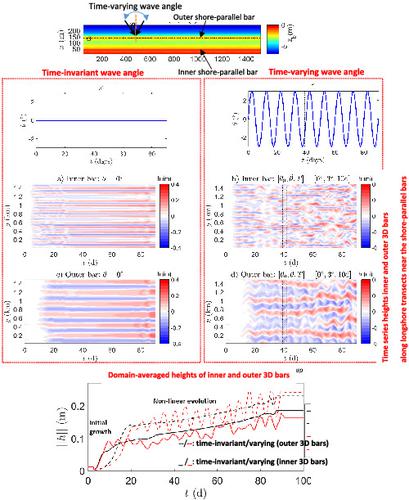当前位置:
X-MOL 学术
›
Earth Surf.Process. Land.
›
论文详情
Our official English website, www.x-mol.net, welcomes your
feedback! (Note: you will need to create a separate account there.)
Modelling the response of a double‐barred sandy beach system to time‐varying wave angles
Earth Surface Processes and Landforms ( IF 2.8 ) Pub Date : 2021-03-03 , DOI: 10.1002/esp.5107 A. Nnafie 1 , A. S. Driessen 1 , H. E. Swart 1 , T. D. Price 1
Earth Surface Processes and Landforms ( IF 2.8 ) Pub Date : 2021-03-03 , DOI: 10.1002/esp.5107 A. Nnafie 1 , A. S. Driessen 1 , H. E. Swart 1 , T. D. Price 1
Affiliation

|
Sandy beaches typically have one or more shore‐parallel bars with superimposed smaller‐scale three‐dimensional (3D) bars. Knowledge of their morphodynamic behaviour under more realistic wave conditions is limited. This study investigates the response of beaches with two shore‐parallel bars to sinusoidally time‐varying angles of incidence, using a non‐linear morphodynamic model. Different periods and amplitudes of this sinusoidal variation are considered, as well as different time‐mean wave angles. For time‐invariant and normally incident waves, results show that alongshore rhythmic 3D bars form in the domains of inner and outer shore‐parallel bars. The 3D bars in the inner domain are coupled at half the outer‐bars wavelength. This phase coupling breaks up when the wave angle varies in time. Initially, regular 3D bars form in the inner domain (free behaviour), which become irregular when 3D bars develop in the outer domain (forced behaviour). The heights of the 3D bars oscillate with time, reaching maximum values when the forcing period is comparable to the system adjustment time scale (∼ 10–20 days). For a time‐varying wave angle around an oblique mean, alongshore migrating 3D bars emerge in both inner and outer domains. In contrast, for an oblique (constant) wave angle, 3D bars only form in the inner domain and they hardly migrate alongshore. For any forcing period, the dominant response period of the oscillating bar heights is at half the forcing period when waves are (on average) normally incident, and it equals the forcing period when waves are on average obliquely incident. Compared with time‐invariant angles, heights of inner and outer 3D bars are (on average) smaller and larger, respectively, when the angle varies with time, particularly for forcing periods in the order of the system adjustment time scale. Increasing the amplitude of the time‐varying wave angle weakens bar growth. Explanations of these results are also provided.
中文翻译:

模拟双栅栏沙滩系统对时变波角的响应
沙滩通常具有一个或多个沿岸平行的钢筋,并叠加有较小比例的三维(3D)钢筋。在更现实的波浪条件下,它们的形态动力学行为的知识是有限的。本研究使用非线性形态动力学模型研究了具有两个岸平行杆的海滩对正弦时变入射角的响应。考虑了这种正弦变化的不同周期和幅度,以及不同的时均波角。对于时不变波和法向入射波,结果表明,沿岸有节奏的3D条形图形成于内部和外部沿岸平行条形图的区域中。内域中的3D条在外条波长的一半处耦合。当波角随时间变化时,该相位耦合破裂。最初,规则的3D条形图在内部区域(自由行为)形成,当3D条形图在外部区域(强制性行为)发展时,规则的3D条形变得不规则。3D条的高度会随着时间而摆动,当施力周期与系统调整时标相当时,最大值会达到最大值(〜 10–20天)。对于围绕斜均值的随时间变化的波角,在内部和外部区域都出现了沿岸迁移的3D条形。相反,对于倾斜(恒定)的波角,3D条形图仅在内部区域中形成,并且几乎不会沿海岸迁移。对于任何推力周期,当波浪(平均)垂直入射时,摆杆高度的主导响应周期为推力周期的一半,并且等于平均斜向入射波浪时的推力周期。与时不变角度相比,当角度随时间变化时,内部3D条和外部3D条的高度(平均)分别较小和较大,尤其是对于按系统调整时间范围的强制时段而言。随时间变化的波角幅度增加会削弱条形的增长。
更新日期:2021-03-25
中文翻译:

模拟双栅栏沙滩系统对时变波角的响应
沙滩通常具有一个或多个沿岸平行的钢筋,并叠加有较小比例的三维(3D)钢筋。在更现实的波浪条件下,它们的形态动力学行为的知识是有限的。本研究使用非线性形态动力学模型研究了具有两个岸平行杆的海滩对正弦时变入射角的响应。考虑了这种正弦变化的不同周期和幅度,以及不同的时均波角。对于时不变波和法向入射波,结果表明,沿岸有节奏的3D条形图形成于内部和外部沿岸平行条形图的区域中。内域中的3D条在外条波长的一半处耦合。当波角随时间变化时,该相位耦合破裂。最初,规则的3D条形图在内部区域(自由行为)形成,当3D条形图在外部区域(强制性行为)发展时,规则的3D条形变得不规则。3D条的高度会随着时间而摆动,当施力周期与系统调整时标相当时,最大值会达到最大值(〜 10–20天)。对于围绕斜均值的随时间变化的波角,在内部和外部区域都出现了沿岸迁移的3D条形。相反,对于倾斜(恒定)的波角,3D条形图仅在内部区域中形成,并且几乎不会沿海岸迁移。对于任何推力周期,当波浪(平均)垂直入射时,摆杆高度的主导响应周期为推力周期的一半,并且等于平均斜向入射波浪时的推力周期。与时不变角度相比,当角度随时间变化时,内部3D条和外部3D条的高度(平均)分别较小和较大,尤其是对于按系统调整时间范围的强制时段而言。随时间变化的波角幅度增加会削弱条形的增长。











































 京公网安备 11010802027423号
京公网安备 11010802027423号